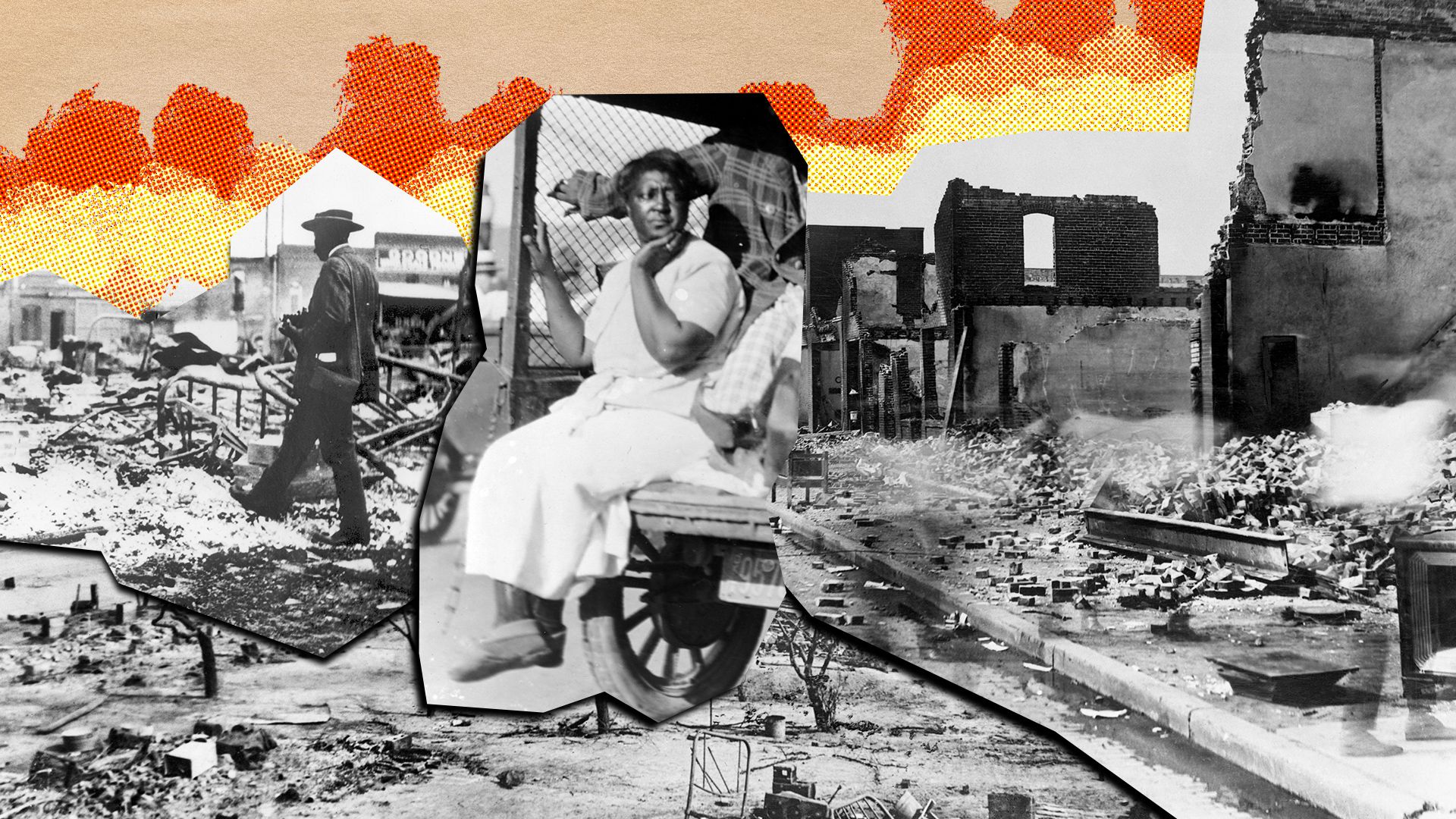100 Year Anniversary: The Massacre of Black Wall Street
29 May 2021
29 May 2021
100 Year Anniversary: The Massacre of Black Wall Street
One hundred years ago, thousands of Black Tulsa, Oklahoma residents built a self-sustaining community that supported hundreds of Black-owned businesses. It was known as “Black Wall Street.”
May 30 marks the 100th anniversary of the Tulsa Race riots, an act of domestic terrorism which has been described as “the single worst incident of racial violence in American history.”
- 300 Greenwood residents killed
- 9,000 Greenwood residents left homeless
- 1,200 Greenwood buildings destroyed
Tulsa’s Black Wall Street in the early 1900’s was made up of 40 blocks of Black-owned businesses, restaurants, services, banks, and homes.
Most of the city’s 10,000 Black residents lived and worked in the prosperous, beautiful district of Greenwood.
It was self-contained and self-sustaining. Black residents owned the houses, banks, stores, restaurants, and theatres. It was a thriving neighbourhood — an American success story. But not everyone in Tulsa felt that way.
The KKK was putting down roots throughout the city. Mob justice was on the rise. Lynching’s were common. And the police were often nowhere to be found.

On the morning of May 30th 1921, a few seconds in a building in downtown Tulsa brought all of those tensions to a head. Two teenagers — a Black shoe shiner named Dick Rowland, and a White elevator operator named Sarah Page — crossed paths in an elevator.
The most common explanation is that Rowland just stepped on Page’s foot after the doors closed.
Page cried out, and it brought a nearby clerk running.
No one knows what Page told the police. But whatever she said…the police didn’t think it was worth investigating until the next day.
May 31st. The day everything went up in flames.

The police, one Black officer and one white — went to Rowland’s house to bring him in.
The afternoon edition of the Tulsa Tribune, featuring an inflammatory headline, was released at 3PM.
“We are going to lynch that negro, that Black devil who assaulted that girl.”
An hour later, the death threats started.
When the calls began, the sheriff and his deputies barricaded Rowland in a cell in the County Courthouse.
But the narrative of the Tulsa massacre was going to have very little to do with that cell.
Word had spread throughout Tulsa that Rowland was in danger. Black Tulsans gathered at the Dreamland Theatre, the pride and joy of Greenwood. 24 hours later, it would be rubble.
The police hadn’t stopped lynching’s before. Black Greenwood residents figured that the only solution was to take matters into their own hands.
Black Tulsans went to the courthouse to offer help to the deputies protecting Rowland. And the mob was not pleased.
A White Tulsan reached for a Black Tulsan’s gun, and started a struggle. The shot that resulted might have been an accident, but the hundreds that followed it over the next 24 hours were not.
To the whites at the courthouse, that errant shot was permission to unleash the rage that had been building for hours.
But really, this was a rage that had been burning as long as wealthy, thriving Greenwood had been in Tulsa.
That night, the white mob burned Black Wall Street to the ground.

White Tulsans who were deputised en masse just hours earlier arrested 6,000 Black residents that night, holding them in makeshift confinement camps for weeks.
By noon on June 1, white rioters had burned down 35 city blocks in Greenwood: dozens of Black-owned businesses that had anchored the neighbourhood, hundreds of homes, and half a dozen churches. Ten thousand Greenwood residents were left homeless.
Fifteen years of Black wealth and self-sufficiency were razed in one night. In the aftermath, the Tulsa City Commission passed fire ordinances that blocked the rebuilding of Greenwood. So many of Tulsa’s Black residents had no choice but to just leave.
Most of the victims of the massacre were piled into unmarked graves and buried. And for decades after, what happened that night was buried, too.

****
It took 80 years for the city to release an official report on the massacre, which recommended multiple forms of restitution, including financial reparations for survivors and their families. Calls for those reparations have been dismissed at multiple levels of the justice system, including the U.S. Supreme Court.
As of 2019, the city of Tulsa has yet to award reparations to the families of survivors and victims of the massacre. The total estimated financial loss, taking into account the destruction of both private residential property and property in the business district would be about $50-100 million in today’s currency. The neighbourhood, in addition to being subjected to the on-the-ground assault, was bombed from above by planes carrying White assailants.
****
REQUIRED READING ON THE TULSA MASSACRE
The Tulsa Race Riot and Three of Its Victims, by B.C. FranklinAn unpublished manuscript written 10 years after the massacre by a witnessing survivor.
Black Wall Street: The African American Haven That Burned and Then Rose From the Ashes, by Victor LuckersonA reported, researched look at the glory, razing, and rebuilding of Greenwood.
Death in a Promised Land: The Tulsa Race Riot of 1921, by Scott EllsworthThe first comprehensive history of the events leading up to, during, and after the massacre.
Tulsa Race Riot: A Report by the Oklahoma Commission to Study the Tulsa Race Riot of 1921The published findings of an independent expert panel on the consequences of the massacre.
‘They Was Killing Black People,’ by DeNeen L. BrownA reported article about the lingering damages of the massacre, and how it affects Tulsa today.
Writing: Natalie Chang. Illustration: Clayton Henry
For more information visit here
Header Illustration: Aïda Amer/Axios. Photos: Corbis, Oklahoma Historical Society, Bettmann Archive/Getty Images





